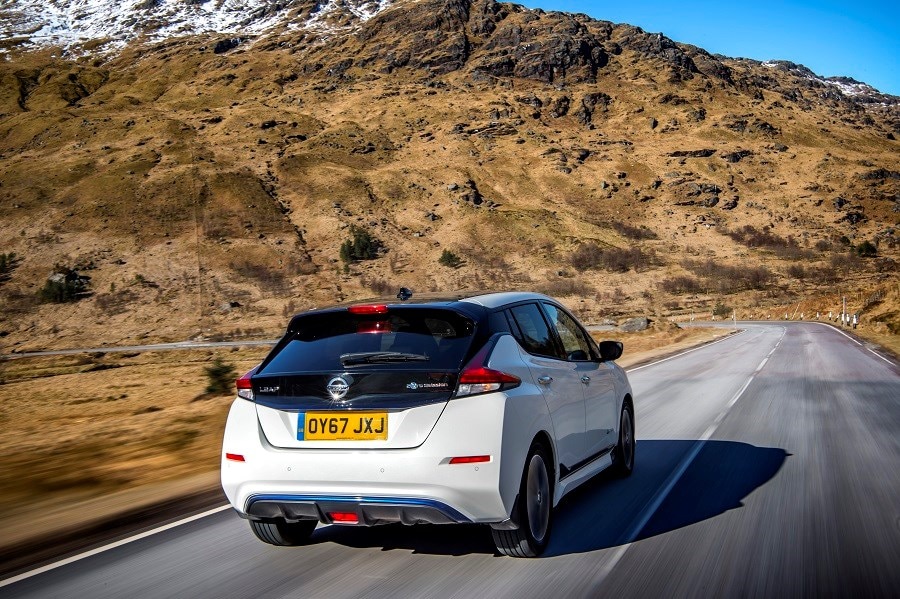Latest model
Nissan unveiled an all-new second-generation Leaf in September 2017, which promises a much-improved electric range of up 242 miles (although a more realistic 168-mile range is given for ordinary driving conditions).
Nissan has ramped up the technology offered, too, with the Leaf being the first European model offered with ‘ProPilot’; this advanced adaptive cruise control system can drive semi-autonomously, and also has the capability to park itself without any driver involvement.
Another highlight of the new Leaf is the new ‘e-Pedal’, a regenerative braking system that allows you to control your speed with just one foot. As soon as you lift off the accelerator, the car brakes, allowing for a more seamless driving experience.
It also looks quite different to the model it replaces, with a new ‘V-motion’ grille, signature lighting and two-tone roof, giving it a far more modern look than the car it replaces.
More recently, Nissan has offered the Leaf with an even more powerful battery pack — a 62kWh unit — in a variant known as the ‘E+’. It offers an improved electric range of up to 239 miles, and has now been added as a permanent addition to the range-topping Tekna trim following a successful spell as a special edition model.
Another new trim— the 3.Zero, adds a larger eight-inch touchscreen with improved connectivity, which aims to improve on the outdated graphics provided in the standard car.
Value for money
As with the original Leaf, Nissan has ensured that its EV remains an affordable choice, although prices have risen with the latest update to accommodate the increased amount of tech fitted to the car.
Prices start from £27,995 for the entry-level Leaf, although it comes as standard with automatic lights, wipers, and a seven-inch touchscreen with Apple CarPlay and Android Auto. It also comes with the Safety Shield pack, which includes autonomous emergency braking, lane-keep assist and high beam assist to name but a few features. It’s still more expensive than a comparable petrol or diesel model, but the gap is certainly getting narrower. It’s also worth remembering that the government offers an incentive of £3,500 towards all EVs.
On the used market, the Leaf is available little as £6,000, which is a bargain considering how cheap it will be to run. You should be aware that first-generation Leafs came with the option of owning or leasing the battery – the latter option existed to make the initial price cheaper, although you have to pay between £55 and £75 per month to lease the battery, depending on your mileage.
Examples whose batteries were purchased outright when new are therefore more expensive; you can expect to pay around £1,500 for examples that don’t require the lease. More desirable 30kWh cars with a longer range start from around £12,500.
High demand for the current-generation Leaf has helped keep used values high, with the cheapest nearly-new examples starting at £23,000, which isn’t too much of a discount when you consider the £3,500 discount offered on brand new cars. With that said, buying a Leaf on the used market will mean beating the waiting list and benefitting from a small but welcome saving.
Looks and image
The last Leaf was an inoffensive-looking model, but it certainly wasn’t the last word in style. The second-generation car is certainly an improvement, but it’s still quite bland to look at, in our opinion.
That said, the new V-motion front end – similar to that of the Qashqai and Juke – brings a certain edge to the model, as do LED daytime running lights and rear lights. Tekna models also benefit from LED headlights. Overall, the Leaf offers understated electric motoring, which will appeal to many.
For all the advancements that came in the new Leaf, the interior is somewhat lacking in flair, with none of the tech or modern feel you find on rivals. All models minus the discontinued Visia trim come with a standard seven-inch touchscreen, which offers Apple CarPlay and Android Auto, a reversing camera, Bluetooth and DAB radio. It’s worth noting that the graphics on this touchscreen are out-dated, and it’s not particularly intuitive to use. The larger eight-inch screen fitted to ‘3.Zero’ models should amend this.
The interior quality is also a mixed bag, with plenty of soft touch materials offset by some rather cheap and scratchy plastics. It feels sturdy, though.
The Leaf is effortless to drive, with swift performance delivered from its torquey electric motor, allowing for a 0-60mph dash in under eight seconds. It’s not designed to be a sports model, but it feels rapid in comparison to other hatchbacks with similar power outputs. It’s also relaxed and comfortable to drive, although the suspension is a bit too firm but as with many EVs, this setup is necessary due to the additional weight of the batteries.
The aforementioned e-Pedal is also a fantastic feature of the Leaf. It allows you to just use the accelerator for both speeding up and slowing down courtesy of a regenerative braking system. It can take some time to get used to, and drivers who don’t like also have the option to turn it off. It’s ideal for commuting, too, particularly in slow-moving traffic where the Pro Pilot-fitted Tekna version can drive semi-autonomously.





